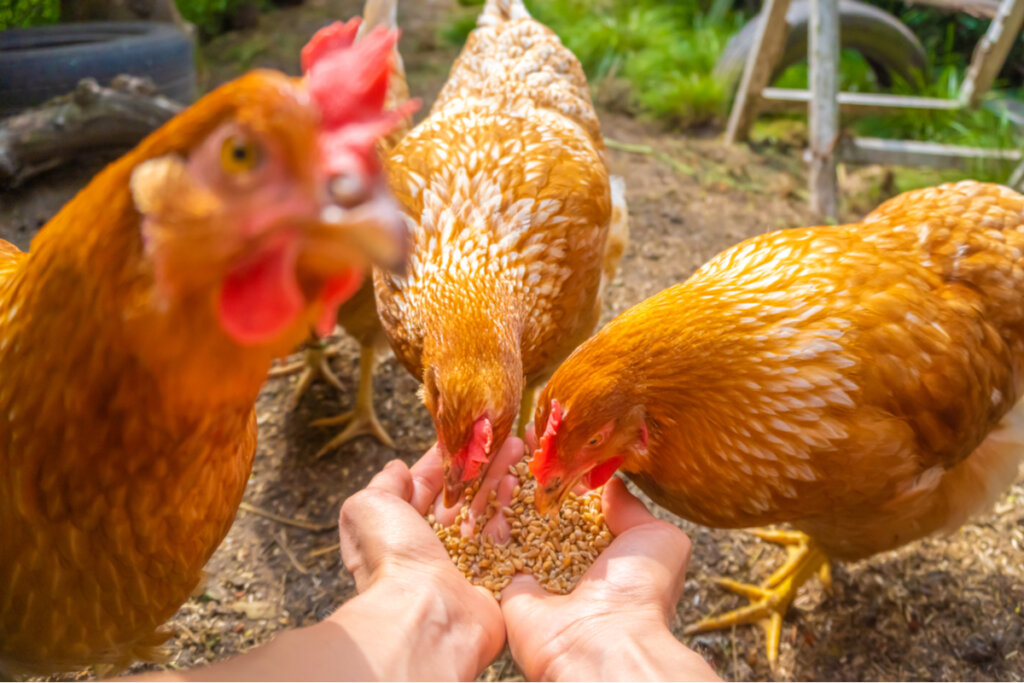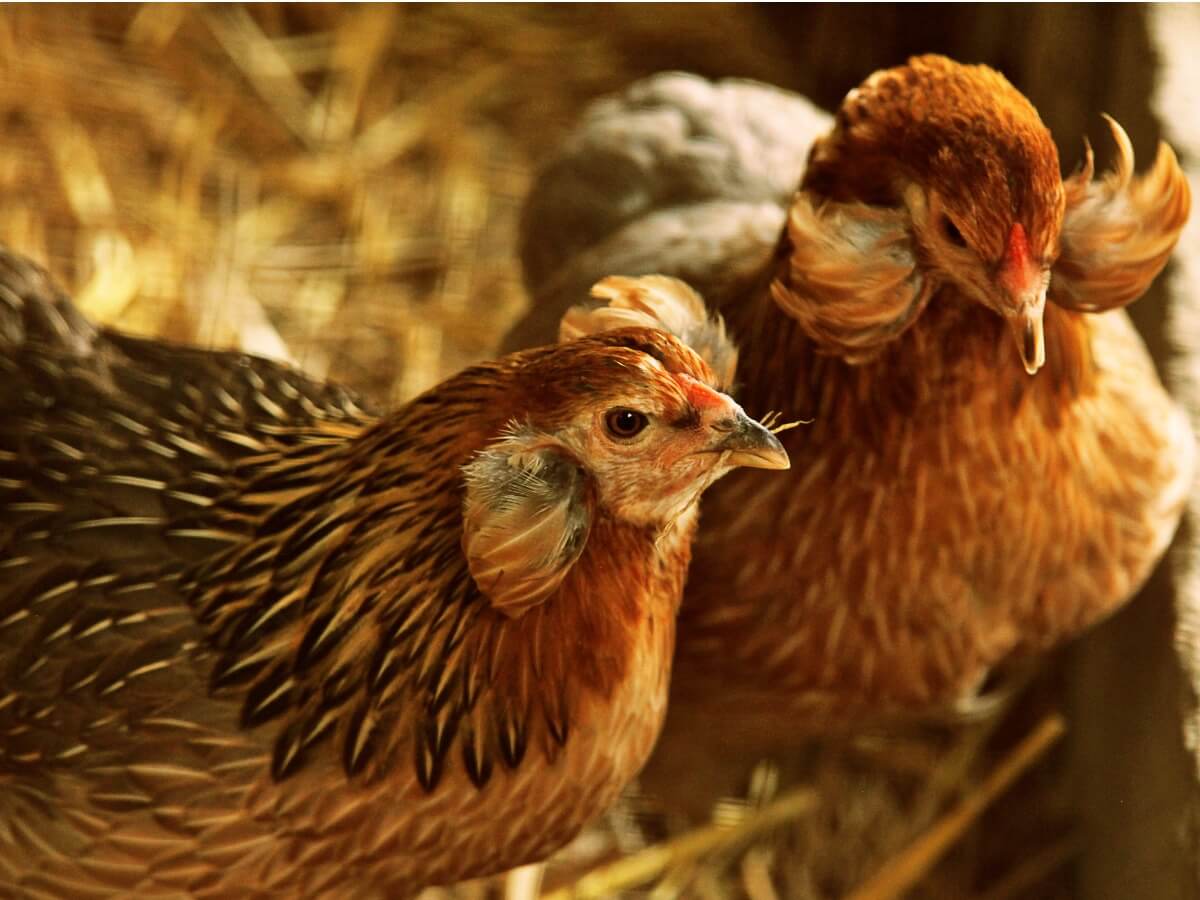All About Chicken Behavior!

These birds are the great unknown, full of surprises and complexity. True chicken behavior is an enigma for anyone who doesn’t live with them, despite all the years they have been domesticated in human environments.
Chickens are birds belonging to the order Galliformes, specifically to the family Phasianidae. Their wild ancestors were capable of flying small distances, but today’s species can barely rise to the top of a tree. They’re small birds, weighing 4 kilos (8.8 lbs) at most, but you will surely love them after reading this article.
Chicken behavior
Chickens spend more than half the day busy looking for food. They’re shy birds and, even within human farms, they have predators, such as foxes, mustelids, or wolves. When they’re not foraging, it’s common to see them display some of these behavior patterns if they’re in a suitable environment:
- Flapping: They flap beat their wings with force, but without taking flight. It’s a movement designed to loosen and strengthen their wings, as well as to drop old feathers and check for parasites.
- Grooming: By extracting oil from their uropygial gland with their heads and beaks, chickens polish and clean their feathers.
- Thermoregulation: Chickens are very sensitive to high temperatures, so they have different behaviors to cool down in hot weather. Some of them include drinking water instead of eating, spreading their wings, or panting with an open beak. When, on the other hand, they’re cold, they usually fluff their feathers to retain air between them and thus keep them warm.
- Sand bathing: This act has social functions —they can be seen bathing in a group—, thermoregulation and self-care, because, with this action, the chickens also get rid of mites and other parasites they may have on their feathers.

Social behavior
They’re gregarious birds that are organized hierarchically (see the article at the end of this post). Using their pecking order, the hens establish their dominance until an alpha remains, which usually occupies the best places to sleep and eat, usually next to the dominant rooster. Submissive behavior is shown by lowering the head and fleeing with the legs slightly bent.
Roosters have their own hierarchy, parallel to that of the females, which also includes territoriality and threatening behaviors.
Usually, groups are made up of a dominant rooster, perhaps a subordinate young rooster, and the hens. The males fulfill the role of protectors of the group and the females follow them within the territory that they mark as theirs. It’s common to see all the hens resting around the male, who remains upright and vigilant.
When the groups reach around 25 individuals, the pecking order is enough to keep the peace in the group. However, in places where more than 80 specimens are packed in – such as in the exploitation industry – attacks are more common and the hierarchy is based more on body size and crest.
In addition, chickens are able to distinguish whether another specimen is their direct relative or not. They tend to form alliances more easily with those inbred chickens, so introducing new members to the group can lead to serious attacks if not done correctly.
Communication in the behavior of chickens
More than 30 different vocalizations have been documented in chickens, all of them with their own function: laying eggs, riding, warning of danger, and even peaceful sounds when they all rest together. The roosters are the ones that emit the famous songs at dawn, although it’s common to hear them sporadically throughout the day.
Reproductive behavior
Chickens are polygamous birds, that is, the dominant male is the one that reproduces with the females of the group. However, in large groups, you can see some monogamous pairs, in which the rooster protects its partner from other males. The most common behaviors in hen reproduction are these ones:
- Courtship: The rooster exhibits the size and color of its crest and breast. Subsequently, it lowers a wing to the ground and moves in circles in a courtship dance. Females, if receptive, lower their heads and lift their tails.
- Laying: Once fertilized, the hens will look for places at ground level, protected by bushes and with a suitable temperature.
- Incubation: During this period, the hen is said to be “broody”. It can lose weight and some feathers in the pectoral and abdominal region, which facilitates the transfer of heat to the eggs. Incubation lasts about 20 days, during which the hen will only leave the nest to take a short walk, feed, and drink.
Eating behavior
Chickens spend most of their waking hours foraging for food, scratching the ground with their feet, and then pecking at what they find in the disturbed soil. Despite being primarily granivorous, they can also consume small insects.
Their behavior is different depending on the food they’re consuming: if it’s an insect, the chickens will first peck it to see its reaction. If it defends itself and is deemed dangerous, they’ll leave it alone and walk away.
Chicken behavior under stress
Stress in chickens has been observed in poultry farms, where they live in crowded conditions and can’t carry out their natural behavior. In these places, it’s common to see serious assaults and other behavior such as the following:
- Pecking: This consists of plucking its own feathers through excessive grooming. It’s identified by revealing areas of skin.
- Cannibalism: Sometimes chicken pecks become so insistent that they end up piercing the skin and consuming entire sections of tissue.
- Avian hysteria: In other cases, the stress is so intense that the hens end up taking short flights or flapping uncontrollably. A panic ensues that usually spreads to the rest of the birds.

As you can see, chicken behavior isn’t limited to clucking and scratching the ground. The people who take care of them know that their hierarchy is complex and their communication efficient. Seeing them beyond their stigma as animals destined for consumption implies discovering sociable, curious, empathetic birds with an incredible maternal instinct.
All cited sources were thoroughly reviewed by our team to ensure their quality, reliability, currency, and validity. The bibliography of this article was considered reliable and of academic or scientific accuracy.
- Costa, L. S., Pereira, D. F., Bueno, L. G. F., & Pandorfi, H. (2012). Some aspects of chicken behavior and welfare. Brazilian Journal of Poultry Science, 14, 159-164.
- The Startling Intelligence of the Common Chicken. (s. f.). Scientific American. Recuperado 26 de julio de 2021, de https://www.scientificamerican.com/article/the-startling-intelligence-of-the-common-chicken/?error=cookies_not_supported&code=0995b0f1-4b7c-41a2-af57-e9b2037249f2
- Edgar, J. L., Lowe, J. C., Paul, E. S., & Nicol, C. J. (2011). Avian maternal response to chick distress. Proceedings of the Royal Society B: Biological Sciences, 278(1721), 3129-3134.